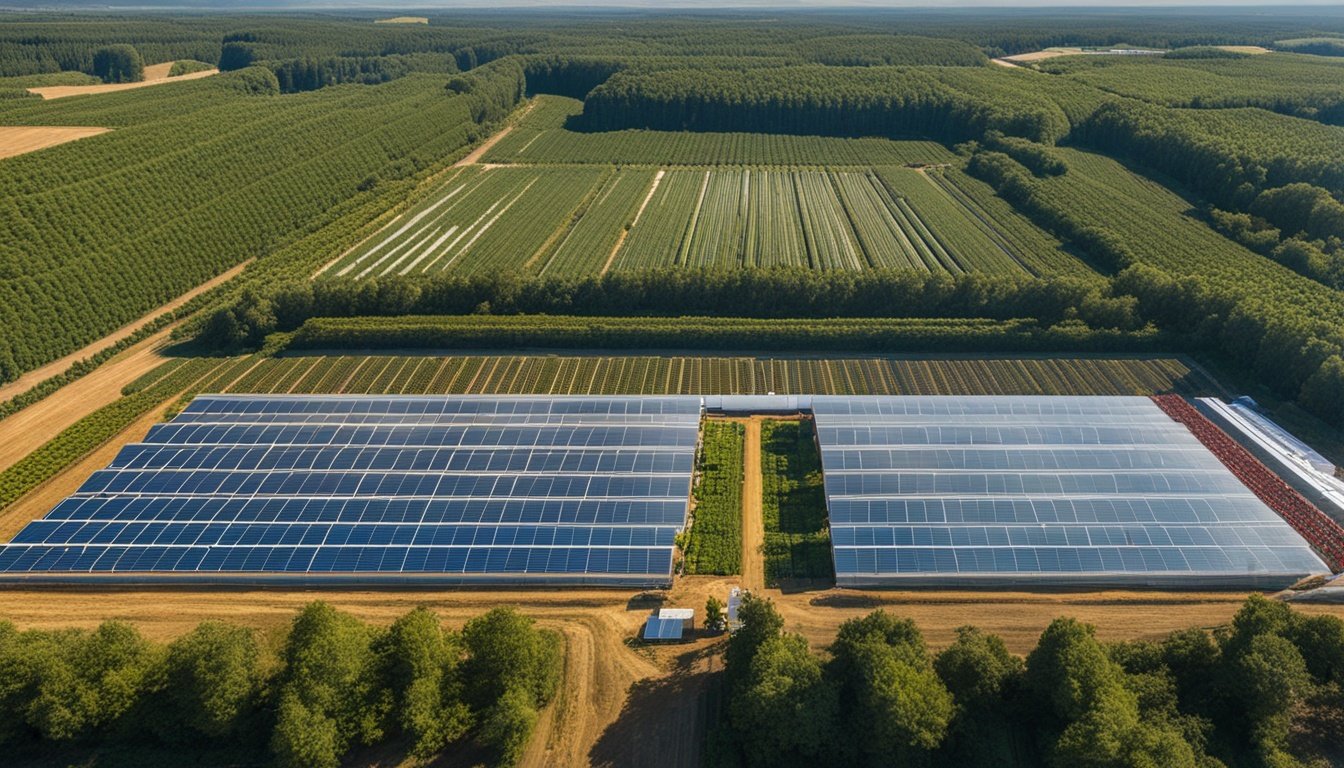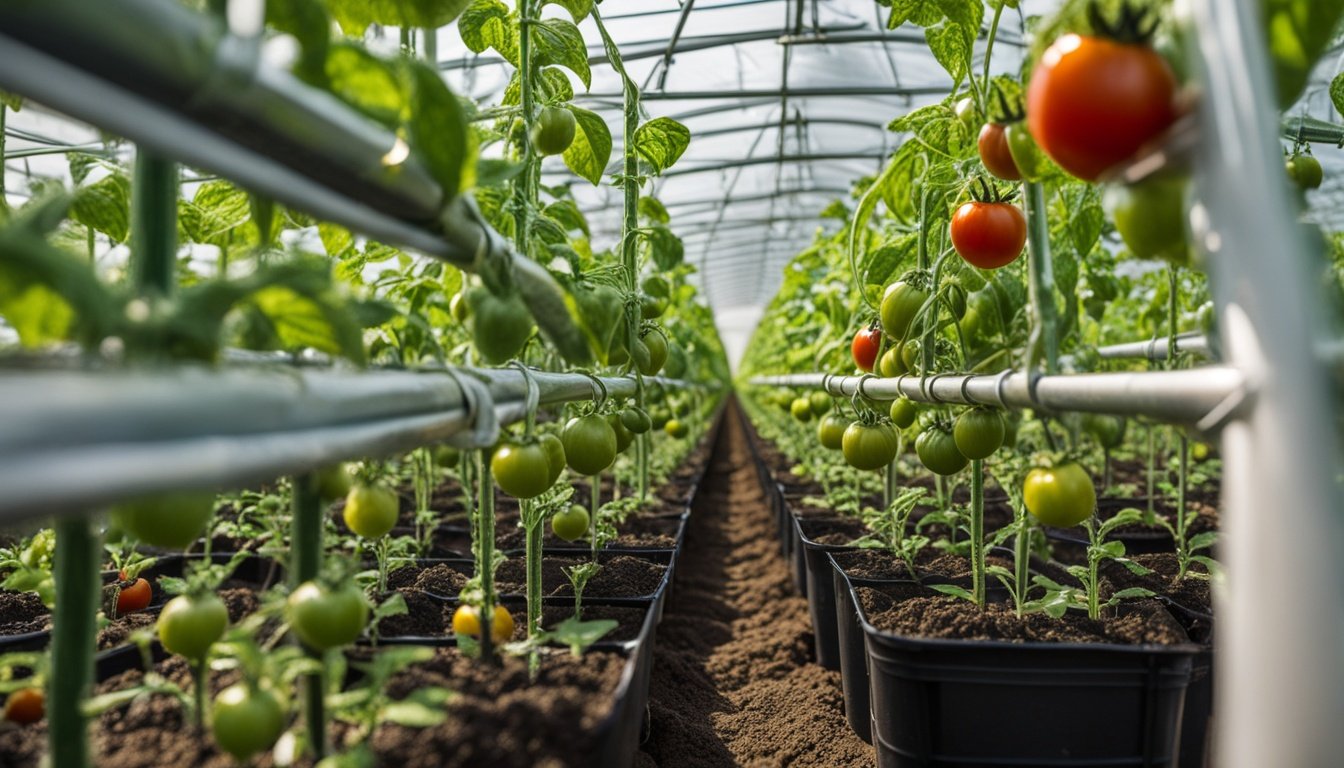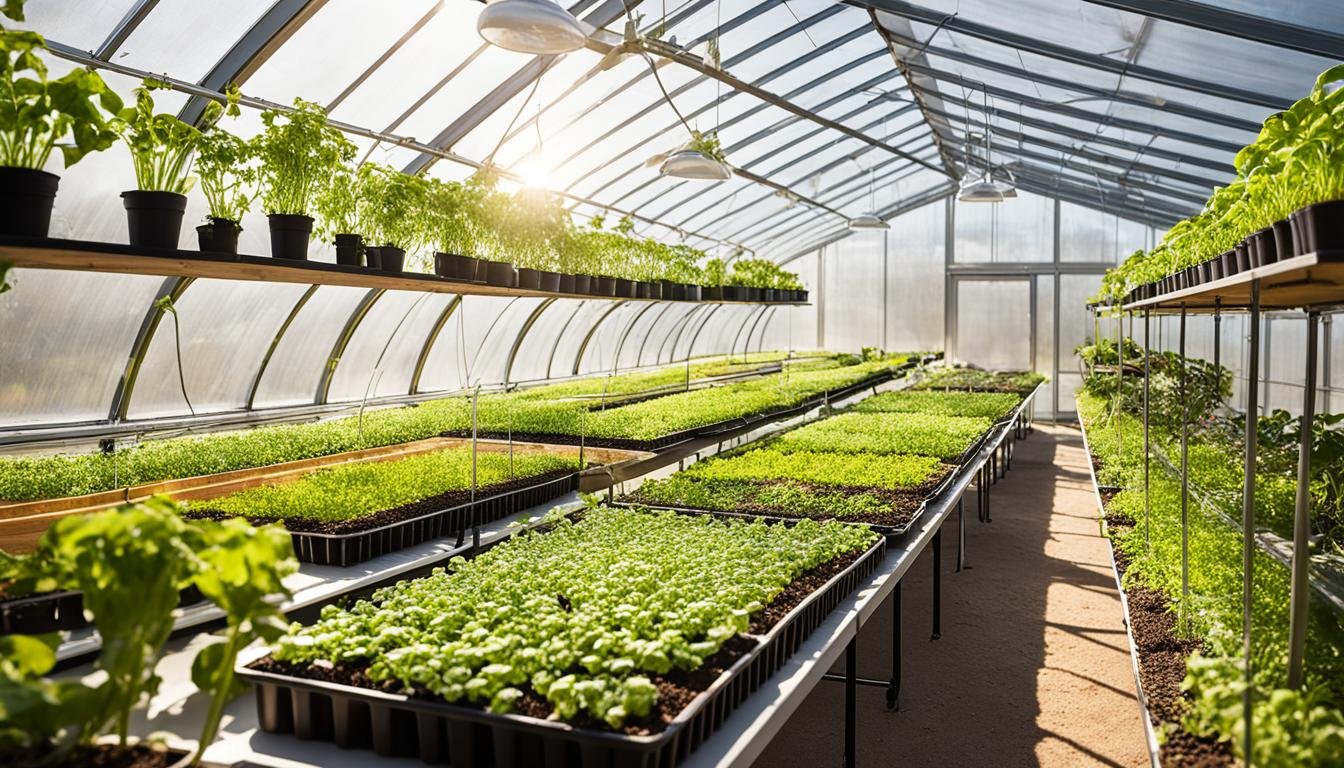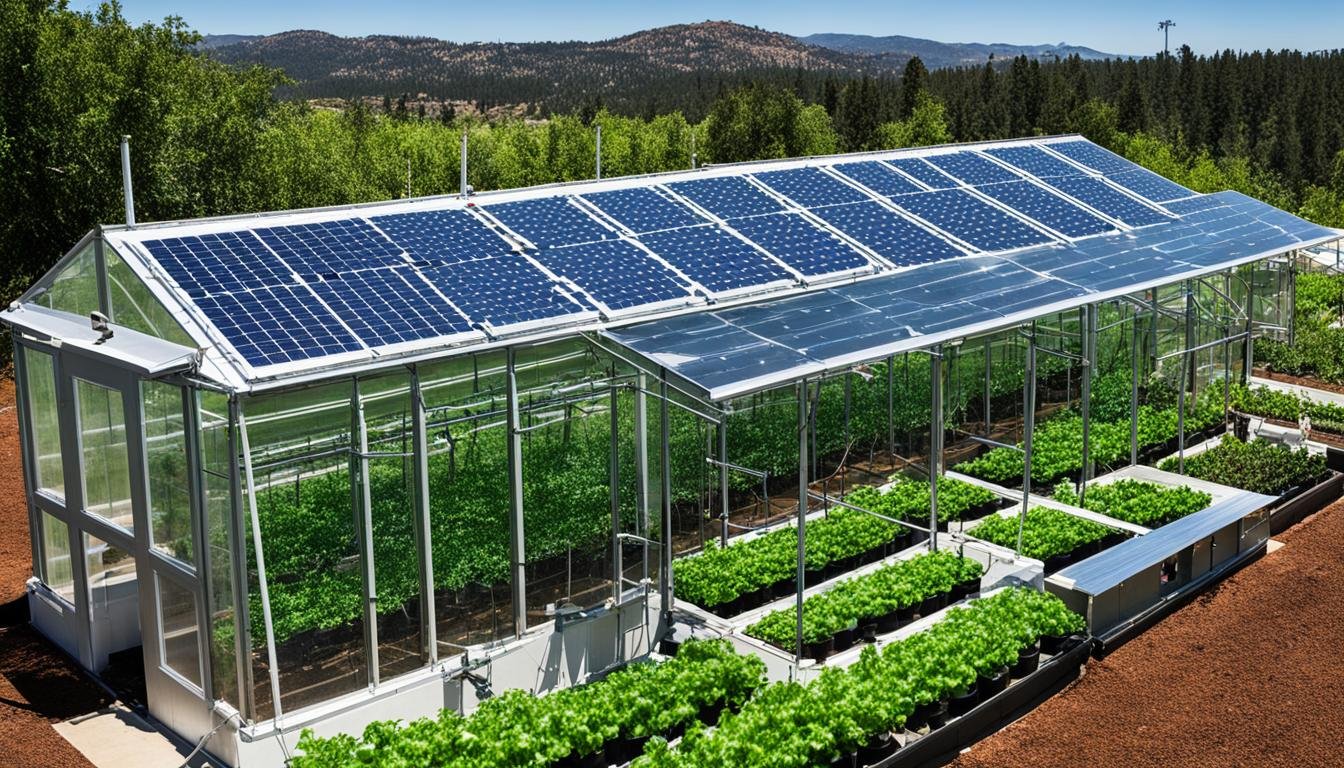In today’s world, we face big challenges. It’s time to focus on solutions in farming. Organic greenhouse farming is a great way to start. It follows principles that care for nature and promote healthy soil. This method includes using hydroponic systems and managing pests naturally. It helps fight climate change and makes food supply safer.
Conventional farming is a big source of greenhouse gases. But, organic farms are different. They store more carbon in the soil and help slow climate change. There’s less use of fossil fuels and more focus on healthy soil. This not only helps the climate. It also supports many different plants and animals.
Organic farming is good for people and the economy, too. Places with lots of organic farms see higher incomes and lower poverty. It’s a growing field that brings more money to farmers. It also creates more jobs and helps rural areas grow. This means better lives for farmers and their communities.
One of the best things about organic farming is the lack of harmful pesticides. This keeps farmworkers and nearby people safe from health problems. In the long run, it makes a healthier world for everyone.
Organic greenhouse farming offers a lot of hope. It’s based on caring for the earth, being fair to people, and making money in a good way. By choosing this path, we can make a world that’s rich, green, and lasting. For our children’s children, this is a way to a brighter future.
Introduction to Organic Greenhouse Farming
Organic greenhouse farming is becoming more popular in the world of sustainable agriculture. It provides a way to grow crops indoors, following strict organic rules. This farming style is not only for big farms. Small market gardeners and new growers are also joining in.
The way organic greenhouse farming works can vary a lot. Some use fancy glass buildings that control the temperature year-round. Others use more basic structures. But no matter the setup, they all share the same organic farming values.
Definition of Organic Greenhouse Farming
Organic greenhouse farming means growing crops indoors organically. This includes not using synthetic pesticides or fertilizers. Instead, farmers use natural ways to take care of pests and enrich the soil.
It’s not just about avoiding bad stuff. It’s also about keeping the soil healthy and the plants diverse. Farmers do this by changing up the crops they grow and planting different things close together.
Importance of Organic Greenhouse Farming
Choosing organic greenhouse produce is good for people and the planet. It keeps harmful chemicals out of our food. Plus, it lets us enjoy fresh, nutritious foods all year.
This way of farming is also kind to the earth. Greenhouses can use clean energy and cut down on pollution. This helps our planet stay healthy for the future.
On top of all this, organic greenhouses help local economies. They offer farmers a chance to grow their business while meeting the demand for organic food.
| Aspect | Organic Greenhouse Farming | Conventional Agriculture |
|---|---|---|
| Pesticide use | Prohibited | Common |
| Fertilizers | Organic (compost, manure, etc.) | Synthetic |
| Energy use | Renewable sources (solar, geothermal) | Fossil fuels |
| Soil health | Prioritized (crop rotation, cover cropping) | Often overlooked |
| Biodiversity | Encouraged (companion planting, diverse crops) | Limited (monocultures) |
In the end, organic greenhouse farming is a great path forward. It lets us grow food in a way that is healthy for us and our planet. By choosing these foods, we support a better future in farming.
Advantages of Organic Greenhouse Farming
Organic greenhouse farming is good for the planet, our health, and the economy. It uses sustainable methods like managing soil health and using local energy. This way, it makes our food system stronger and kinder to the planet.
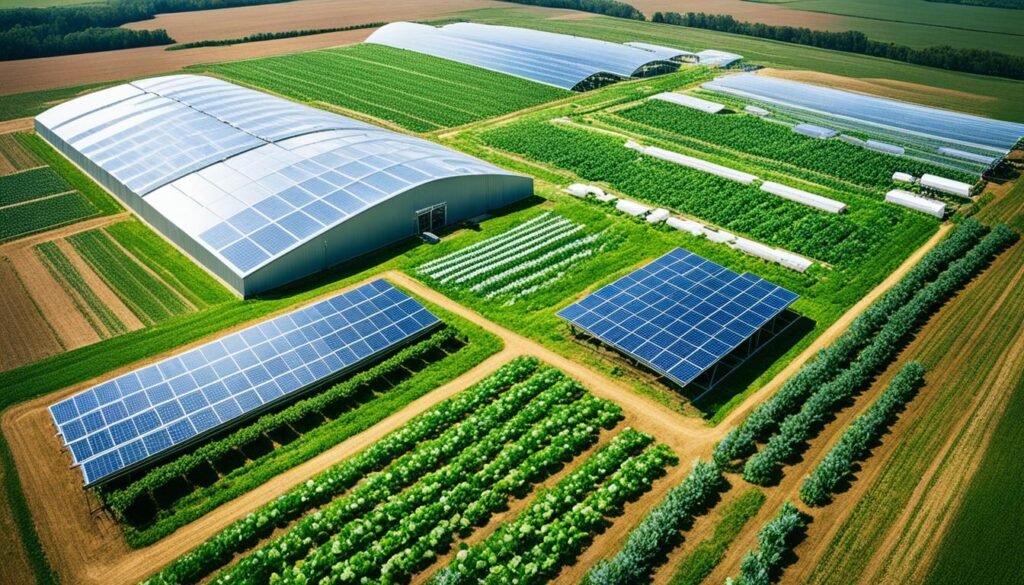
Environmental Benefits
Organic farming helps the earth a lot. It keeps the soil healthy with natural ways, which means more carbon stays in the ground. This fights climate change. Organic farms can keep 26% more carbon over time than other farms.
Organic farms avoid pesticides and harmful chemicals. This helps keep our water clean and supports more plants and animals. Studies show organic farms have more species living there than other farms.
Health Benefits
Health wise, organic foods are much better. Without synthetic chemicals, these foods are safer to eat. They help us stay healthy by avoiding harmful residues.
Organic farming methods also keep the soil full of nutrients. By rotating crops and planting certain plants together, they stay strong. This makes the food we eat good for us too.
Economic Benefits
Choosing organic is more than green, it’s good for business too. The organic food market is growing faster than non-organic. This opens up new jobs and chances for farmers.
In places with lots of organic farming, families make more money. Poverty goes down as well. This approach helps communities thrive while protecting the environment.
| Organic Farming Practice | Environmental Benefit |
|---|---|
| Soil fertility management | Increases carbon sequestration and builds healthier soils |
| Prohibition of synthetic pesticides and fertilizers | Reduces groundwater pollution and supports biodiversity |
| Crop rotation and companion planting | Prevents soil depletion and disease buildup |
| Use of organic seeds and seedlings | Maintains integrity of farming operations and ensures adherence to organic principles |
Organic Greenhouse Farming Methods
In organic greenhouse farming, techniques are used to grow crops in a careful way. This is done to meet organic standards. It includes using methods that don’t need soil, like hydroponics, to make plants healthy.
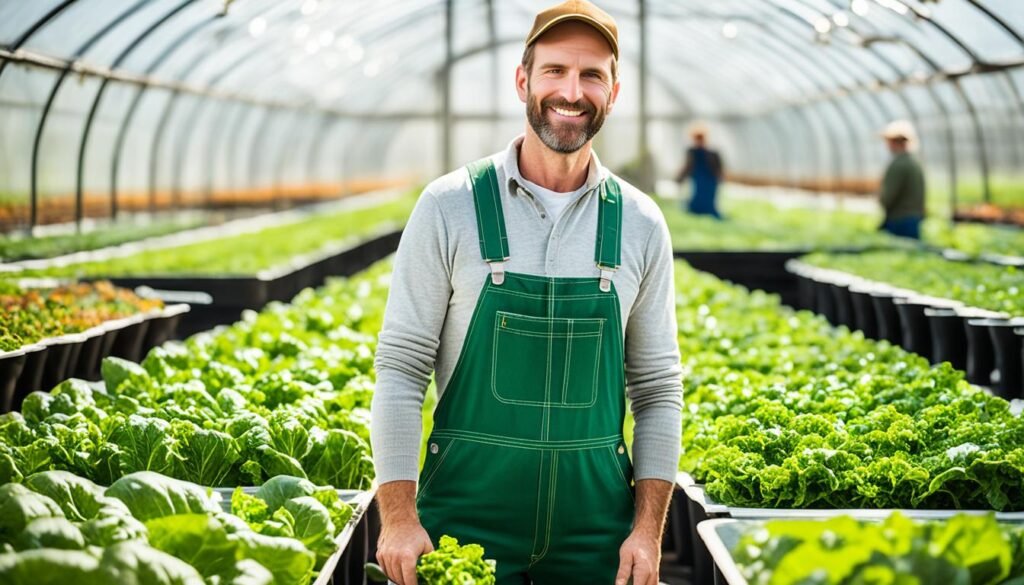
Soil Management Techniques
Managing soil health is vital in organic greenhouse farming. To make the soil better, organic growers add things like compost. They also use techniques such as crop rotation to keep the soil full of nutrients and to keep pests away.
One key rule is that compost must be kept at a certain temperature, depending on how it’s made. For good compost, the C:N ratio should be between 15-20:1. It should also have a nice smell and the right pH level.
Integrated Pest Management (IPM)
Growers in organic greenhouses prefer IPM to pesticides. IPM uses natural ways to control pests. This includes using helpful bugs and making sure the crop areas are clean.
The OMRI checks and okays sprays for organic farming. They make sure the products are safe and follow the rules. Also, there’s a special program that certifies pros who focus on keeping gardens and farms natural.
Renewable Energy Sources
Organic greenhouse farmers use renewable energy to save money and protect the environment. They use the sun and even heat from composting to keep the greenhouse plants warm.
Some groups help farmers use green methods with grants and advice. They support organic and sustainable farming, including using renewable energy.
| State | Number of Certified Organic Operations |
|---|---|
| Massachusetts | 179 |
| Connecticut | 123 |
| Rhbody”> | |
| Rhode Island | 27 |
| New Hampshire | 121 |
| Maine | 494 |
| Vermont | 759 |
| New York | 1,330 |
| New Jersey | 99 |
Thanks to these methods, growers can make high-quality, eco-friendly food. They can meet the need for organic, local produce.
Challenges in Organic Greenhouse Farming
Organic greenhouse farming offers many benefits. It helps in sustainable farming and gives crops a controlled setup to grow. Yet, farmers face several challenges. The main one is competing with big, non-organic farms. To stand out, small organic farms need creative ways to make money and do well.
Being able to grow crops all year is key for organic greenhouse farmers. But it’s not simply about growing one crop all year. They need to change what they grow to meet market demand. The cost of labor and energy is high. Cutting down on these costs is vital for making a profit.
| Challenge | Statistical Data |
|---|---|
| Low global representation | Organic agriculture represents less than 1% of global agricultural production systems |
| Limited production area | The European organic greenhouse production area is estimated to be around 6,000 hectares |
| High energy consumption | In heated high-tech greenhouses, the yearly energy consumption for tomato production is around 36 m3 gas m-2 soil, corresponding to approximately 360,000 m3 gas ha-1, with a yield of around 500 tonnes per hectare |
| Lower productivity in unheated greenhouses | Unheated greenhouses have lower energy consumption compared to heated greenhouses, but productivity is relatively lower due to suboptimal growing conditions |
| Concerns over copper-based fungicides | The use of copper-based fungicides in unheated greenhouses, especially in Mediterranean regions, is a growing concern due to contamination of food and soil |
Organic greenhouse farmers need to adapt to new markets. They should keep up with what consumers want. This can mean trying new crops, growing methods, or marketing strategies. The goal is to offer what people are looking for in high-quality, sustainably grown food.
There’s a debate about hydroponic farming. This method is good for controlled growth and uses less soil. But, it’s not considered organic. This debate is making people think about how to keep organic values while using new growing methods.
The economic sustainability of renewable energy use in organic greenhouse production is still under discussion, as the initial investment costs and long-term viability of these systems must be carefully considered.
Even with its challenges, organic greenhouse farming is very promising. By tackling these issues with new ideas, working together, and supporting good policies, the future of organic farming looks bright. This effort is not just for the U.S. It aims to help farming worldwide.
Organic Greenhouse Farming vs. Conventional Agriculture
Organic greenhouse farming is much better for the earth than conventional ways. Conventional farming uses a lot of chemicals that harm our health and the planet. These methods are a big part of the pollution that’s causing climate change. Actually, they make up a good portion of the emissions from food production.
Comparison of Environmental Impact
Organic farming avoids using these risky chemicals. So, it’s kinder to the environment. It helps keep soil and water cleaner. Yet, it may release more greenhouse gases because it needs more land.
Still, the good from organic farming outweighs the bad for the planet. It helps soil and wildlife thrive.
Comparison of Crop Quality and Yield
Conventional farming is known for feeding many people around the world. But its use of chemicals worries some about food safety. On the other hand, organic food is seen as healthier and tastier, as it avoids these chemicals.
However, organic farms usually produce less food than conventional farms. As our population grows, we’ll need more food. So, balancing this demand with healthy farming is a big challenge.
Both methods have their pros and cons. We need to think carefully about how we grow our food. It’s up to all of us to make choices that help our food system be sustainable for the future.
